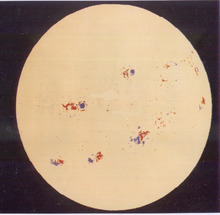The term magnetogram has two meanings, used separately in the contexts of magnetic fields of the Sun and the Earth.
In the context of the magnetic field of the Sun, the term magnetogram refers to a pictorial representation of the spatial variations in strength of the solar magnetic field. Magnetograms are often produced by exploiting the Zeeman effect (or, in some cases, the Hanle effect), which George Ellery Hale employed in the first demonstration that sunspots were magnetic in origin, in 1908. Solar magnetograms are produced by suitably instrumented telescopes referred to as magnetographs. Some magnetographs can only measure the component of the magnetic field along the line of sight from the observer to the source (the field's "longitudinal" component). One example of such a "line-of-sight" or "longitudinal" magnetograph is the Michelson Doppler Imager (MDI), a scientific instrument that takes magnetograms of the Sun in order to measure velocity and magnetic fields in the Sun's photosphere to learn about the convection zone and about the magnetic fields which control the structure of the solar corona. A vector magnetograph also measures the component of the magnetic field perpendicular to the line of sight (the field's "transverse" component), from which all three components of the magnetic field vector can be deduced. Two examples include the National Solar Observatory's SOLIS instrument and the Helioseismic and Magnetic Imager aboard NASA's Solar Dynamics Observatory satellite.
In the context of geophysics, a magnetogram is a measurement of temporal variation the local strength and direction of the geomagnetic field. Such magnetograms have existed since Victorian times, and the British Geological Survey has preserved records from the 1850s, showing the effects of the 1859 Carrington Event,[1] the worst magnetic storm known to have hit Earth.
See also
References
External links
- For a discussion of solar magnetograms, see the article "Solar Magnetism: Magnetograms"
- For a repository of geophysical magnetograms, see "Historical UK magnetic observatory magnetograms and yearbooks". British Geological Survey. Retrieved 17 February 2011.
